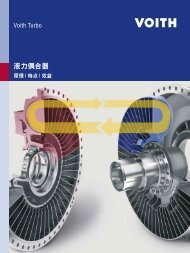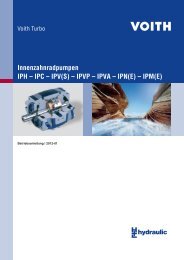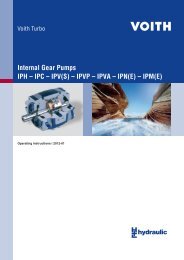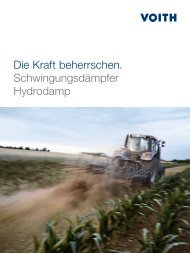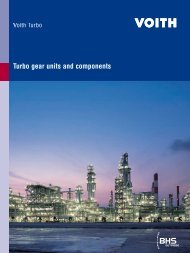Download PDF - Voith Turbo
Download PDF - Voith Turbo
Download PDF - Voith Turbo
You also want an ePaper? Increase the reach of your titles
YUMPU automatically turns print PDFs into web optimized ePapers that Google loves.
Capacity of hydrostatic pump<br />
1,0<br />
0,9<br />
0,8<br />
0,7<br />
0,6<br />
0,5<br />
0,4<br />
0,3<br />
0,2<br />
0,1<br />
0,0<br />
0%<br />
10%<br />
20%<br />
By-pass principle<br />
<strong>Voith</strong> flow system<br />
Saving<br />
30%<br />
40%<br />
50%<br />
60%<br />
Fan speed<br />
Fig. 5: Hydrostatic fan drive during traction, comparison of by-pass<br />
principle and <strong>Voith</strong> flow system.<br />
70%<br />
80%<br />
90%<br />
average savings in annual cycle approx. 10%<br />
engine output this may correspond to<br />
7,200 l of fuel per year (table 2).<br />
Some of the advantages of hydrodynamic<br />
drives mentioned above also<br />
apply to the hydrostatic drive:<br />
- constant operating temperature of<br />
cooling circuits,<br />
- adapted power requirement, and<br />
-a self-sufficient system.<br />
In addition to this, the fan speed can<br />
now be freely selected within a wide<br />
range.<br />
100%<br />
Water<br />
Electronic<br />
control<br />
Diesel<br />
engine<br />
Oil<br />
Particularly advantageous, however, are<br />
the high power density and the possibility<br />
to expand the system to drive components<br />
such as compressors or generators<br />
at a constant speed. For the latter<br />
this is done using purely hydraulic control<br />
with an accuracy of ± 2.5 % (fig. 6).<br />
Assumption:<br />
Generator<br />
Compressor<br />
Cooler<br />
group<br />
Fig 6: Hydrostatic drive of several components by a multiple pump unit.<br />
• max. pump drive power 100 kW<br />
• mean power savings 10 kW<br />
• 3,000 operating hours per year<br />
Energy savings: 10 kW * 3 000 h/Jahr = 30 000 kWh/year<br />
Fuel savings: 30 000 kWh * 200 g/kWh = 6 000 kg/year<br />
Table 2: Energy- and fuel savings<br />
6 000 kg / 0.83 kg/l ≈ 7 200 l/year<br />
9




